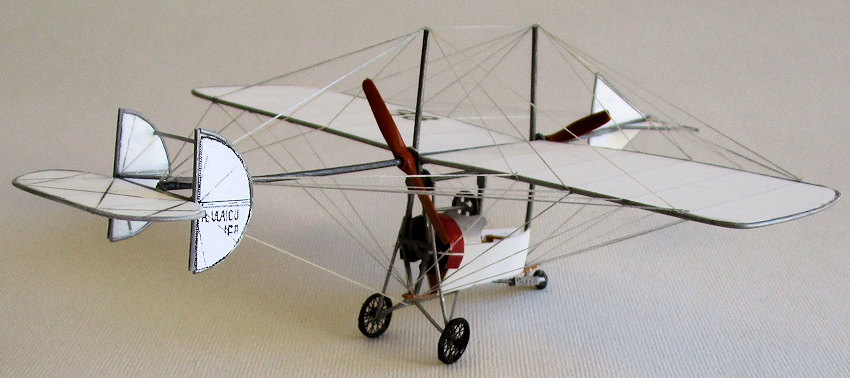
1/72 1911 Vlaicu II
| KIT #: | |
| PRICE: | |
| DECALS: | Home made |
| REVIEWER: | Chris Peachment |
| NOTES: | Made from 10 and 20 thou plastic card, and rod. |

| HISTORY |
What
you are looking at here, dear reader, is the very dawn of Romanian aviation.
There were several great pioneers at work before WWI in that country, and much
good work was done. Trajan Vuia was the earliest,
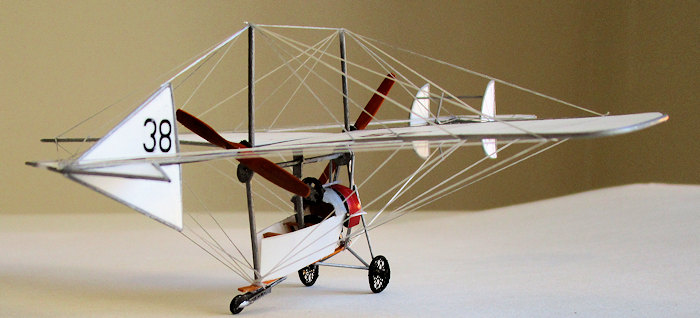 and in 1906 he made a flight
of 12 yards, at an altitude of all of 12 inches off the ground, in an object
which looked very like a four wheeled adult-sized baby carriage with wings. He
is generally credited with making the first flight in a monoplane of
fundamentally modern design and layout, and Santos-Dumont later admitted that he
was influenced by Vuia's designs.
and in 1906 he made a flight
of 12 yards, at an altitude of all of 12 inches off the ground, in an object
which looked very like a four wheeled adult-sized baby carriage with wings. He
is generally credited with making the first flight in a monoplane of
fundamentally modern design and layout, and Santos-Dumont later admitted that he
was influenced by Vuia's designs.
Then there was the Romanian aristocrat George Bibescu who qualified for the International Pilot License number 20 in France. He returned to Bucharest and was later instrumental in founding the Federation Aeronique Internationale (FAI), the international regulatory body for aeronautics, of which he was President between 1930 and 1941.
The
more famous Henry Coanda made his early designs and early flights in France and
later Great Britain. Then there was the man portrayed here, Aurel Vlaicu, who was born in
Transylvania, which was then part of t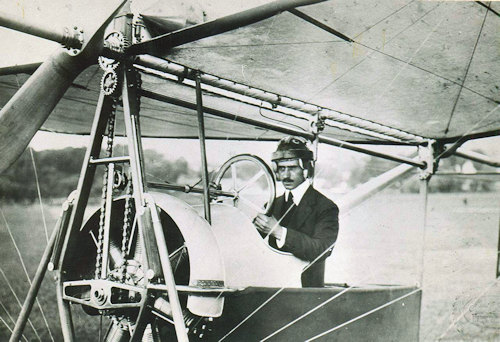 he Austro-Hungarian Empire, and familiar
to all as the birthplace of Count Dracula. His first aircraft, the Vlaicu I, was
constructed at the Army Arsenal at Bucharest and first flown on 17 June 1910, a
day still celebrated in Romania as National Aviation Day.
he Austro-Hungarian Empire, and familiar
to all as the birthplace of Count Dracula. His first aircraft, the Vlaicu I, was
constructed at the Army Arsenal at Bucharest and first flown on 17 June 1910, a
day still celebrated in Romania as National Aviation Day.
The Vlaicu II, modelled here, was an improvement of the basic design. He later constructed two more aircraft, but alas suffered a fatal crash in the second in 1913 while trying to cross the Carpathian mountains, home to the largest and most beautiful virgin forest in Europe. I once walked through the forests there and came across a sign nailed to a tree saying “Please do not annoy the bears”. A sound piece of advice.
The aircraft has one long boom, on which the wings, canard foreplanes and tailplanes are mounted. The fuselage is an under-slung gondola, with a 50hp Gnome Omega rotary engine on the nose. A lay shaft beneath the main boom is driven by a chain from the engine, and in turn drives cogs which connect to the two propellers, one for, one aft, through the hubs of which the main boom passes. The propellers are handed in order to minimise the torque effect.
The wings are simply panels of fabric, stretched around the metal tubular framework, and have no aerofoil section. Since they are flat, lift would have been provided by the “flat-plate” effect, something which Vlaicu obviously grasped, since the aircraft has a marked nose-up attitude on the ground thus providing a high angle of attack.
| CONSTRUCTION |
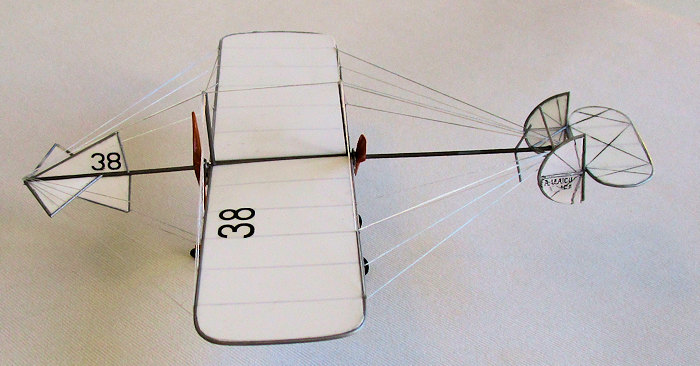 Good scale plans can be found on several of the websites listed
below. One could easily see that the trickiest part of construction was
going to be the nose area with its chains and cogs, and so I began with the fuselage
gondola. The lower beam of the fuselage is a flat strip of card shaped like a ski, on
which are mounted a couple of V-shaped frames. The sides are two oblongs of
card, mounted on the frames and curved toward the back like a boat A simple seat is all that the
cockpit contains, since directional control was done by means of a large steering
wheel mounted on a control rod above the nose. King posts at the mid point and rear are simply rod. The front
kingpost is a rhomboid of square section card. The engine from the spares box was
mounted on a card firewall, and then the fun began.
Good scale plans can be found on several of the websites listed
below. One could easily see that the trickiest part of construction was
going to be the nose area with its chains and cogs, and so I began with the fuselage
gondola. The lower beam of the fuselage is a flat strip of card shaped like a ski, on
which are mounted a couple of V-shaped frames. The sides are two oblongs of
card, mounted on the frames and curved toward the back like a boat A simple seat is all that the
cockpit contains, since directional control was done by means of a large steering
wheel mounted on a control rod above the nose. King posts at the mid point and rear are simply rod. The front
kingpost is a rhomboid of square section card. The engine from the spares box was
mounted on a card firewall, and then the fun began.
The lay shaft is mounted on the king posts with three tiny cogs made
of punched card threaded on it. In this scale, it is impossible to reproduce
the links of a chain,without being reduced to a cross-eyed, gibbering lunatic. So simple
lengths of narrow rod
sufficed. You then have the delicate task of organising the front undercarriage struts in and
 around the chain and engine arrangement. The tubular wing frames were made from lengths of rod, judiciously
bent to shape using warm water to make them pliable, and then pinned down to a
cork-board to maintain their shape. The wing fabric is very thin card, scored
underneath to suggest the panel joins. The wing join to the main boom is especially
flimsy, and before doing the rigging, I reinforced it underneath with some extra rod which
fortunately is invisible. The foreplanes and tailpanes were run up from rod, and then filled with with the same thin card as the wings. Above all remember to mount the propellers on the main boom before
fixing the
foreplanes and tailplanes at each end. Or else there will be much hair tearing
and grinding of teeth. Note that the two rudders at the front are connected by a short
strut at the top. The whole of the elevator is hinged at its rear edge.
around the chain and engine arrangement. The tubular wing frames were made from lengths of rod, judiciously
bent to shape using warm water to make them pliable, and then pinned down to a
cork-board to maintain their shape. The wing fabric is very thin card, scored
underneath to suggest the panel joins. The wing join to the main boom is especially
flimsy, and before doing the rigging, I reinforced it underneath with some extra rod which
fortunately is invisible. The foreplanes and tailpanes were run up from rod, and then filled with with the same thin card as the wings. Above all remember to mount the propellers on the main boom before
fixing the
foreplanes and tailplanes at each end. Or else there will be much hair tearing
and grinding of teeth. Note that the two rudders at the front are connected by a short
strut at the top. The whole of the elevator is hinged at its rear edge.
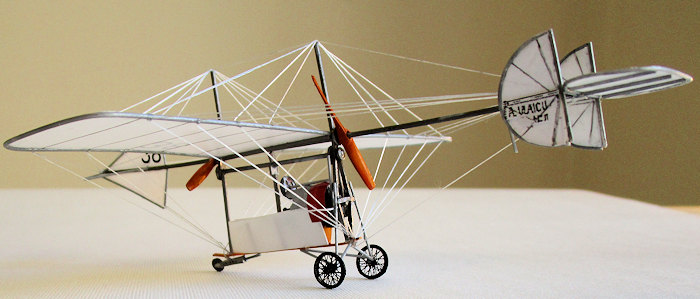 Rigging is clearly shown on the scale plans, and was done by my
usual method of
elastic thread coloured silver, secured by spot of superglue applied with a
sharpened toothpick. Considerably more structural strength could have been
acquired by using non-stretchy thread, but I like to work with what I know.
Rigging is clearly shown on the scale plans, and was done by my
usual method of
elastic thread coloured silver, secured by spot of superglue applied with a
sharpened toothpick. Considerably more structural strength could have been
acquired by using non-stretchy thread, but I like to work with what I know.
A simple engine cowl was fashioned from the lead foil off a wine bottle, and since this is a colourless, black and white beast, I left the cowl in that nice shade of burgundy red, just to add a splash of colour. No doubt the Director of the National Museum of Aviation in Bucharest will denounce this red cowl to the world as a travesty. But I say that Vlaicu might have liked it.
 Finally I added some wire wheels from the etched Eduard set of WWI
wheels, sat back to look at it and let out a wail of horror. The beast was
sitting four-square on the ground with the wings parallel to the table surface. Something had gone
wrong with the measurements. After brooding on the possibility of hurling it to its
doom from the
balcony, I investigated the undercarriage legs and realised they were too short.
They all had to come off, and it was no easy task with small sharp nail
scissors and tweezers being used like pliers. Then came the dreary business of
repeating oneself all over again, but with slightly longer main struts. Finally it
acquired the correct nose up attitude.
Finally I added some wire wheels from the etched Eduard set of WWI
wheels, sat back to look at it and let out a wail of horror. The beast was
sitting four-square on the ground with the wings parallel to the table surface. Something had gone
wrong with the measurements. After brooding on the possibility of hurling it to its
doom from the
balcony, I investigated the undercarriage legs and realised they were too short.
They all had to come off, and it was no easy task with small sharp nail
scissors and tweezers being used like pliers. Then came the dreary business of
repeating oneself all over again, but with slightly longer main struts. Finally it
acquired the correct nose up attitude.
The tail wheel, the tiniest wheel in my spares box, is mounted on a long box section strut with lightening holes in it, and short rod. “A. Vlaicu” was hand-lettered onto some decal sheet for the rudders, together with a small and indecipherable word in Romanian, which I hope no Romanian speaker is going to tell me is rude. A couple of number 38s were applied from the decal box and that was it.
| CONCLUSIONS |
An elegant, rather spindly machine which puts me in mind of the
wondrous
inventions of the British cartoonist Rowland Emett, whose whimsical machines are well worth looking up on Google. They include The Featherstone-Kite Openwork
Basketweave Mark Two Gentleman’s Flying Machine. Two copies of this d elightful
machine exist, one of which is displayed in a glass case in the Merrion Centre,
Leeds, while the other is on permanent display at the Mid America Science
Museum in Hot Springs, Arkansas. The Flying Machine houses a small cat which is
used for night vision. Emmet also built the Forget-Me-Not computer, which used an elephant
in its innards to provide the memory.
elightful
machine exist, one of which is displayed in a glass case in the Merrion Centre,
Leeds, while the other is on permanent display at the Mid America Science
Museum in Hot Springs, Arkansas. The Flying Machine houses a small cat which is
used for night vision. Emmet also built the Forget-Me-Not computer, which used an elephant
in its innards to provide the memory.
Vlaicu himself, a handsome man with a fine moustache, is memorialised on the Romanian 50 Lei note, which is worth about £8 or $12.
| REFERENCES |
https://theodorvisanmiu.wordpress.com/category/personalities/
http://www.geocities.ws/huzumstreza/Aircraft_Industry.htm
http://www.earlyaviators.com/evlaicu2.htm
http://www.rcgroups.com/forums/showthread.php?t=1645681
27 June 2016
Copyright ModelingMadness.com
If you would like your product reviewed fairly and fairly quickly, please contact the editor or see other details in the Note to Contributors.